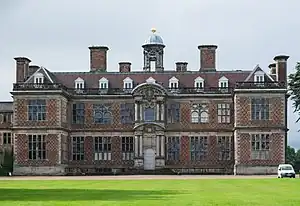The Lord Vernon | |
|---|---|
_-_George_Venables-Vernon_(1710%E2%80%931780)%252C_1st_Baron_Vernon_of_Kinderton_-_653161_-_National_Trust.jpg.webp) Portrait of Venables-Vernon, by John Vanderbank, 1736 | |
| Member of the British Parliament for Lichfield | |
| In office 1731–1747 | |
| Preceded by | Walter Chetwynd Richard Plumer |
| Succeeded by | Richard Leveson-Gower Thomas Anson |
| Member of the British Parliament for Derby | |
| In office 1754–1762 | |
| Preceded by | Viscount Duncannon Thomas Rivett |
| Succeeded by | Lord Frederick Cavendish William Fitzherbert |
| Personal details | |
| Born | George Vernon 9 February 1709 |
| Died | 2 August 1780 (aged 71) |
| Spouses | Hon. Mary Howard
(m. 1733; died 1740)Ann Lee
(m. 1741; died 1742)Martha Harcourt
(m. 1744; died 1780) |
| Children | 9 |
| Parent(s) | Henry Vernon Anne Pigott |
| Residence | Sudbury Hall |
George Venables-Vernon, 1st Baron Vernon (9 February 1709 – 2 August 1780), was a British politician.[1]
Early life
Vernon was born on 9 February 1709. He was the eldest, and only surviving, son of Henry Vernon, of Sudbury, Derbyshire, MP for Staffordshire and Newcastle-under-Lyme, and his wife Anne Pigott, daughter and heiress of Thomas Pigott of Chetwynd by his wife Mary Venables (sister and heiress of Sir Peter Venables of Kinderton, Cheshire).[2]
Career

His father died in 1719, leaving him Sudbury Hall, and in 1728 he assumed, by royal licence, the additional surname of Venables after he had succeeded to the Cheshire estates on the death of his cousin, Anne Venables-Bertie, Countess of Abingdon (wife of Montagu Venables-Bertie, 2nd Earl of Abingdon), in accordance with the will of his uncle and her father, Sir Peter Venables.[2]
Vernon began in politics as a Tory, but by 1754 was a supporter of Administration. He sat as a Member of Parliament, as an Anti-Walpole Whig, for Lichfield from 1731 to 1747 and for Derby from 1754 to 1762.[2]
In 1762 he was raised to the peerage as Lord Vernon, Baron of Kinderton, in the County of Chester.[3]
He lived at Sudbury Hall, one the country's finest Restoration mansions, which now is a Grade I listed building.[4]
Personal life
_-_Martha_Harcourt_(1715%E2%80%931794)%252C_Lady_Vernon_-_653146_-_National_Trust.jpg.webp)
Lord Vernon was married three times and several of his descendants gained distinction. He married firstly the Hon. Mary Howard, daughter of Thomas Howard, 6th Baron Howard of Effingham, in 1733.[1] Together they had a son:[1]
- George Venables-Vernon, 2nd Baron Vernon (1735–1813), who married Hon. Louisa Barbara Mansell, only daughter and heiress of Bussy Mansell, 4th Baron Mansell, in 1757. After her death in 1786, he married Jane Georgiana Fauquier, daughter of William Fauquier, of Hanover in 1786.[4]
- Hon. Mary Venables-Vernon, who married George Anson, MP for Saltash and Lichfield, in 1763.[4]
After her death in 1740 he married secondly Ann Lee, daughter of Sir Thomas Lee, 3rd Baronet, of Hartwell, MP for Chipping Wycombe and Buckinghamshire, in 1741. She died shortly thereafter in 1742.[1]
After her death the following year he married, thirdly, Martha Harcourt, daughter of the Hon. Simon Harcourt (a younger son of Simon Harcourt, 1st Viscount Harcourt) and sister to Simon Harcourt, 1st Earl Harcourt, in 1744.[5] Together they had a son:[1]
- Hon. Elizabeth Venables-Vernon (1746–1826), who married her first cousin, George Harcourt, 2nd Earl Harcourt, in 1765.[4]
- Henry Venables-Vernon, 3rd Baron Vernon (1747–1829), who married Elizabeth Rebecca Anne Sedley, illegitimate daughter and testamentary heiress of Sir Charles Sedley, 2nd Baronet, in 1779. After her death in 1793, he married Alice Lucy Whitefoord, second daughter of Sir John Whitefoord, 3rd Baronet, in 1795.[4]
- Hon. William Venables-Vernon, who died young.[4]
- Hon. Catherine Venables-Vernon (1749–1775)[4]
- Hon. Martha Venables-Vernon (b. 1751)[4]
- Hon. Anne Venables-Vernon (1754–1837)[4]
- Edward Venables-Vernon-Harcourt (1757–1847), the Archbishop of York who married Lady Anne Leveson-Gower, third daughter of Granville Leveson-Gower, 1st Marquess of Stafford, by his second wife Lady Louisa Egerton (eldest daughter of Scroop Egerton, 1st Duke of Bridgewater), in 1784. Edward succeeded to the Harcourt estates on the death of his first cousin, William Harcourt, 3rd Earl Harcourt, in 1830.[4] The 11th, and current Baron Vernon, is descended through Edward.[6]
Lord Vernon died in August 1780, aged 71, and was succeeded in the barony by his son from his first marriage, George. His second son from his third marriage, the Most Reverend the Hon. Edward Harcourt (who assumed the surname of Harcourt) became Archbishop of York and was the grandfather of Sir William Vernon Harcourt and the great-grandfather of Lewis Harcourt, 1st Viscount Harcourt.[1]
The widowed Lady Vernon moved to Grosvenor Square.[7] where she lived until her death in 1794.[1]
References
- 1 2 3 4 5 6 7 Lodge, Edmund (1838). The Genealogy of the Existing British Peerage. Saunders and Otley. p. 503.
- 1 2 3 Brooke, John. "VENABLES VERNON, George (1709-80), of Sudbury, Derbys. and Kinderton, Cheshire". www.historyofparliamentonline.org. History of Parliament Online. Retrieved 5 October 2023.
- ↑ "No. 10205". The London Gazette. 1 May 1762. p. 6.
- 1 2 3 4 5 6 7 8 9 10 Cokayne, George Edward (1898). Complete Peerage of England, Scotland, Ireland, Great Britain and the United Kingdom, Extant, Extinct, Or Dormant. G. Bell & Sons. pp. 27–28. Retrieved 5 October 2023.
- ↑ Jenkins, Philip (2002). The Making of a Ruling Class: The Glamorgan Gentry 1640-1790. Cambridge University Press. pp. 41, 183, 214, 229. ISBN 978-0-521-52194-9. Retrieved 5 October 2023.
- ↑ Mosley, Charles, editor. Burke's Peerage, Baronetage & Knightage, 107th edition, 3 volumes. Wilmington, Delaware, U.S.A.: Burke's Peerage (Genealogical Books) Ltd, 2003, volume 3, page 3995.
- ↑ "Grosvenor Square: Individual Houses built before 1926 Pages 117-166 Survey of London: Volume 40, the Grosvenor Estate in Mayfair, Part 2 (The Buildings)". British History Online. LCC 1980. Retrieved 5 December 2022.
External links
- Kidd, Charles, Williamson, David (editors). Debrett's Peerage and Baronetage (1990 edition). New York: St Martin's Press, 1990.
- Leigh Rayment's Peerage Pages